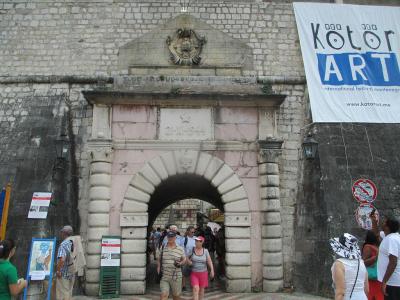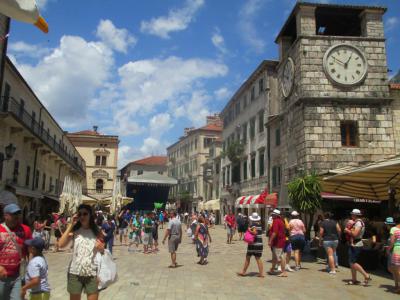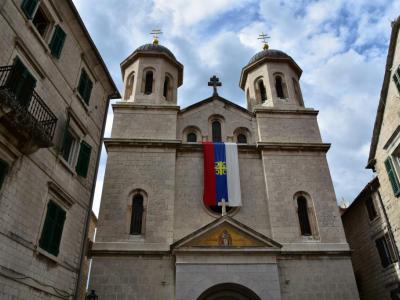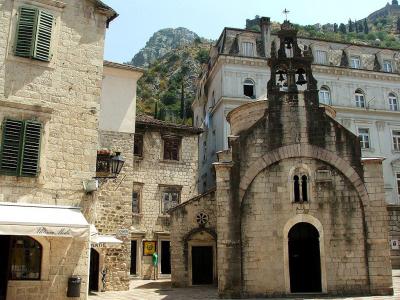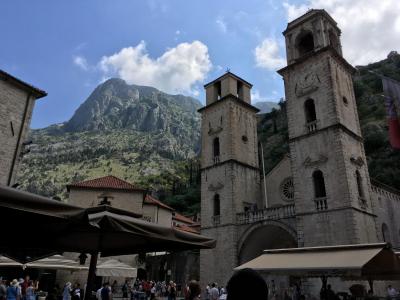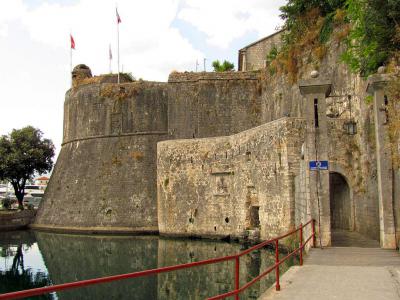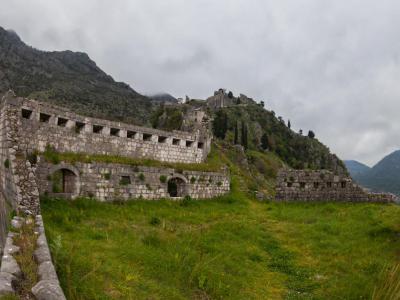Kotor Old City Walking Tour (Self Guided), Kotor
Nestled on the shores of the Bay of Kotor and at the foot of the surrounding mountains, the beautiful fortified city of old town Kotor is a UNESCO World Heritage Site. While it receives less attention than many other settlements from the same period, Kotor is visited by more tourists every year.
The port here has been in use since Ancient Roman times, but most of the fortifications were built during Venetian rule around the 16th century. The Bay of Kotor has been incorrectly called the southern-most European fjord. In reality, it is a ria--a submerged river canyon. Tall limestone cliffs line each side, making the scenery truly spectacular.
The city's most spectacular and picturesque sights include the fortifications, walls, and bastions. The three gates into the city--the Sea Gate, River Gate, and Gurdic Gate--are striking in both their appearances and differences. Also, don't miss Arms Square, Flour Square, and Craftsmen Street to get a taste of what life was like inside the walls.
You'll also find several historic churches here that speak of the multitude of faiths that worked together. Kotor, like many port cities, is a cultural melting pot. Check out the Church of St. Nicholas, the most important Orthodox church in town, as well as the historic and tiny Church of St. Luke.
After you have seen the old city, hike up the hills to the Castle of San Giovanni to take postcard-perfect pictures of the town. The view is stunning. It's the best place to appreciate the city's location, spectacular scenery, and overall beauty. So join us on a walking tour of Kotor to see this magnificent city!
The port here has been in use since Ancient Roman times, but most of the fortifications were built during Venetian rule around the 16th century. The Bay of Kotor has been incorrectly called the southern-most European fjord. In reality, it is a ria--a submerged river canyon. Tall limestone cliffs line each side, making the scenery truly spectacular.
The city's most spectacular and picturesque sights include the fortifications, walls, and bastions. The three gates into the city--the Sea Gate, River Gate, and Gurdic Gate--are striking in both their appearances and differences. Also, don't miss Arms Square, Flour Square, and Craftsmen Street to get a taste of what life was like inside the walls.
You'll also find several historic churches here that speak of the multitude of faiths that worked together. Kotor, like many port cities, is a cultural melting pot. Check out the Church of St. Nicholas, the most important Orthodox church in town, as well as the historic and tiny Church of St. Luke.
After you have seen the old city, hike up the hills to the Castle of San Giovanni to take postcard-perfect pictures of the town. The view is stunning. It's the best place to appreciate the city's location, spectacular scenery, and overall beauty. So join us on a walking tour of Kotor to see this magnificent city!
How it works: Download the app "GPSmyCity: Walks in 1K+ Cities" from Apple App Store or Google Play Store to your mobile phone or tablet. The app turns your mobile device into a personal tour guide and its built-in GPS navigation functions guide you from one tour stop to next. The app works offline, so no data plan is needed when traveling abroad.
Kotor Old City Walking Tour Map
Guide Name: Kotor Old City Walking Tour
Guide Location: Montenegro » Kotor (See other walking tours in Kotor)
Guide Type: Self-guided Walking Tour (Sightseeing)
# of Attractions: 11
Tour Duration: 2 Hour(s)
Travel Distance: 2.2 Km or 1.4 Miles
Author: emily
Sight(s) Featured in This Guide:
Guide Location: Montenegro » Kotor (See other walking tours in Kotor)
Guide Type: Self-guided Walking Tour (Sightseeing)
# of Attractions: 11
Tour Duration: 2 Hour(s)
Travel Distance: 2.2 Km or 1.4 Miles
Author: emily
Sight(s) Featured in This Guide:
- Morska vrata (Sea Gate / Main Gate)
- Trg od Oruzja (Arms Square)
- Crkva Svetog Nikole (Church of St. Nicholas)
- Crkva Svetog Luke (Church of St. Luke)
- Museum Maritimum (Maritime Museum - Grgurin Palace)
- Trg Bokeljske Mornarice (Boka Navy Square)
- Trg od Brasna (Flour Square)
- Katedrala Svetog Tripuna (Saint Tryphon Cathedral and Square)
- Vrata od Gurdicа (Gurdic Gate / South Gate)
- Craftsmen Street
- Tvrdava Svetog Ivana (St. John's Castle)
1) Morska vrata (Sea Gate / Main Gate)
The main entrance to Kotor's fortified city was constructed in 1555 during Venetian rule (1420–1797). You'll notice the winged lion of Saint Mark, Venice's symbol, proudly displayed on the walls here and in a few other spots around town. Above the gate, there's a nod to history with a communist star and a post-World War II inscription that reads, "What belongs to others we don't want, what is ours we will never surrender" – credited to Yugoslav leader Tito. There's also a huge (and quite random) bench outside, perfect for some goofy photos.
Take a look up from outside and picture the old fortified wall in all its former glory. Sure, some parts have crumbled away over time, but it's still pretty amazing to think about how it was built centuries ago. Previously only accessible by sea, the gate has sunk over 70 centimeters since it was erected, all thanks to the weight of its stone blocks!
Additionally, don't miss the beautiful 15th-century stone relief of the Madonna and Child, flanked by Saint Tryphon and Saint Bernard, as you walk through. From there, you're immediately immersed in the charming cobblestone streets of Old Town Kotor – Arms Square!
Take a look up from outside and picture the old fortified wall in all its former glory. Sure, some parts have crumbled away over time, but it's still pretty amazing to think about how it was built centuries ago. Previously only accessible by sea, the gate has sunk over 70 centimeters since it was erected, all thanks to the weight of its stone blocks!
Additionally, don't miss the beautiful 15th-century stone relief of the Madonna and Child, flanked by Saint Tryphon and Saint Bernard, as you walk through. From there, you're immediately immersed in the charming cobblestone streets of Old Town Kotor – Arms Square!
2) Trg od Oruzja (Arms Square) (must see)
This is the big city square you'll step into when entering the walled city of Kotor through the Sea Gate. It's a hub of activity with shops, banks, cafes, restaurants, and some pretty significant historical landmarks. Back in the Venetian days, this place was all about making and storing weapons, especially in the Arsenal building, with the Prince's Palace and Town Guard Tower backing up the military effort.
Soldiers who defended the city would gather here to gear up with weapons and stand their ground. One of the most legendary moments was when they held off the Turkish pirate Hajrudin Barbarossa for three intense days back in 1539.
Besides the Sea Gate, which is the biggest of the three entrances to the city, you'll also spot the 17th-century clock tower (looking older than it really is, thanks to its mix of Baroque and Gothic styles) and a medieval pillar located adjacent. On the west side of the square stands the Rector's Palace, now part of Hotel Cattaro, while the Napoleon Theatre, originally built in 1762 for storing military supplies and food, became one of the very first theaters in the Balkans during the French occupation.
Soldiers who defended the city would gather here to gear up with weapons and stand their ground. One of the most legendary moments was when they held off the Turkish pirate Hajrudin Barbarossa for three intense days back in 1539.
Besides the Sea Gate, which is the biggest of the three entrances to the city, you'll also spot the 17th-century clock tower (looking older than it really is, thanks to its mix of Baroque and Gothic styles) and a medieval pillar located adjacent. On the west side of the square stands the Rector's Palace, now part of Hotel Cattaro, while the Napoleon Theatre, originally built in 1762 for storing military supplies and food, became one of the very first theaters in the Balkans during the French occupation.
3) Crkva Svetog Nikole (Church of St. Nicholas)
The Church of Saint Nicholas, up in the northern part of Kotor's Old Town, catches the eye of believers, history buffs, and regular tourists alike. It started going up in 1902, replacing a church from the 17th century that got wiped out by a fire on Christmas Eve in 1896. You can't miss its grand presence, flanked by two big bell towers capped with black domes sporting shiny gold crosses gifted from Russia.
The mastermind behind the project was the famous architectural engineer Ćiril Iveković, who has left his mark all over the Adriatic coast, from Zadar to Kotor, working on churches, rectories, and other public buildings. A prominent name in the art and architecture scene, he taught at Zagreb's Technical University until passing away in 1933.
The structure itself, designed in Byzantine style, stands tall behind the city wall. Inside, you're in for a treat with the stunning iconostasis finished in 1908 and a vast collection of icons, among which the most famous is the Icon of the Holy Mother of God Trojeručica. Plus, there are many religious texts, artworks, and treasures donated by wealthy Kotor families.
This is the only Orthodox church in Kotor where daily liturgies take place, and best of all, admission won't cost you a dime. You'll see the flag of the Serbian Orthodox Church flying proudly from the front facade.
The mastermind behind the project was the famous architectural engineer Ćiril Iveković, who has left his mark all over the Adriatic coast, from Zadar to Kotor, working on churches, rectories, and other public buildings. A prominent name in the art and architecture scene, he taught at Zagreb's Technical University until passing away in 1933.
The structure itself, designed in Byzantine style, stands tall behind the city wall. Inside, you're in for a treat with the stunning iconostasis finished in 1908 and a vast collection of icons, among which the most famous is the Icon of the Holy Mother of God Trojeručica. Plus, there are many religious texts, artworks, and treasures donated by wealthy Kotor families.
This is the only Orthodox church in Kotor where daily liturgies take place, and best of all, admission won't cost you a dime. You'll see the flag of the Serbian Orthodox Church flying proudly from the front facade.
4) Crkva Svetog Luke (Church of St. Luke)
Alongside the Church of Saint Nicholas lies one of Kotor's five remaining sacred structures built in the Romanesque style. Dating back to 1195, during the Serbian Nemanjić dynasty, it has a single nave layout with a circular-based dome over the central aisle, a semicircular apse on the east end, and a portal on the west side. Despite its modest size compared to its neighbors, like the grand Saint Nicholas, this structure's smaller stature actually worked in its favor, sparing it from earthquake damage that affected many others in town.
Shortly after its completion, Saint Luke's was adorned with frescoes, though only fragments remain on the southern wall. The impressive iconostasis, crafted by Dimitrije Daskal, hails from the 17th-century Boka Kotorska painting school.
What further sets the church apart is its history of housing both Catholic and Orthodox altars. In 1657, during a Turkish invasion, the population of Grbalj sought refuge in Kotor, and the Venetian authorities allowed them to use the then-Catholic place of worship for Orthodox services. This led to the installation of two altars, which remained in use until the French occupation from 1807 to 1814.
An intriguing detail lies beneath your feet in this sacred spot – the floor is comprised of tombstones from communal graves of Kotor's residents. Burials took place within the church until the 1930s, adding another layer of history to this fascinating site.
Shortly after its completion, Saint Luke's was adorned with frescoes, though only fragments remain on the southern wall. The impressive iconostasis, crafted by Dimitrije Daskal, hails from the 17th-century Boka Kotorska painting school.
What further sets the church apart is its history of housing both Catholic and Orthodox altars. In 1657, during a Turkish invasion, the population of Grbalj sought refuge in Kotor, and the Venetian authorities allowed them to use the then-Catholic place of worship for Orthodox services. This led to the installation of two altars, which remained in use until the French occupation from 1807 to 1814.
An intriguing detail lies beneath your feet in this sacred spot – the floor is comprised of tombstones from communal graves of Kotor's residents. Burials took place within the church until the 1930s, adding another layer of history to this fascinating site.
5) Museum Maritimum (Maritime Museum - Grgurin Palace)
Kotor's rich maritime legacy takes center stage in a beautiful early-18th-century Baroque palace, housing three floors of captivating displays. With the help of an audio guide, you'll dive into a treasure trove of photographs, paintings, uniforms, intricately crafted weapons, fancy navigational gadgets, and ship models.
The sailing tradition in Kotor traces back to medieval times, and you can soak in the tales of Kotor's seafarer fraternity, known as the Boka Marine, dating all the way back to the 9th century. The museum is like a time capsule, preserving memories of the city's illustrious seafarers, artists, shipbuilders, craftsmen, politicians, and diplomats who bridged the gap between East and West.
Among the highlights are six bronze relief tables showcasing pivotal events and notable figures from Kotor's turbulent past. You'll also find geographic maps, engravings, and watercolors depicting coastal towns, along with an ethnographic collection that offers a glimpse into Kotor's maritime heyday from the 16th to the 18th century.
Right at the entrance of the palace, keep an eye out for two small cannons symbolizing the endless battle between seafarers and pirates.
The sailing tradition in Kotor traces back to medieval times, and you can soak in the tales of Kotor's seafarer fraternity, known as the Boka Marine, dating all the way back to the 9th century. The museum is like a time capsule, preserving memories of the city's illustrious seafarers, artists, shipbuilders, craftsmen, politicians, and diplomats who bridged the gap between East and West.
Among the highlights are six bronze relief tables showcasing pivotal events and notable figures from Kotor's turbulent past. You'll also find geographic maps, engravings, and watercolors depicting coastal towns, along with an ethnographic collection that offers a glimpse into Kotor's maritime heyday from the 16th to the 18th century.
Right at the entrance of the palace, keep an eye out for two small cannons symbolizing the endless battle between seafarers and pirates.
6) Trg Bokeljske Mornarice (Boka Navy Square)
One of the main squares in the Old Town of Kotor is home to the Grgurin Palace, once the residence of the noble family of the same name. Originally constructed in the 18th century using stones transported from the island of Korcula in Dalmatia (now part of Croatia), it served as a town administration building in the 19th century, before being repurposed to house the collections of the Maritime Museum – a must-visit spot for delving into Kotor and Montenegrin history – starting in 1900. Sadly, the building was completely leveled in the earthquake of 1979 but was reconstructed in the early 1980s.
Another highlight here is Karampana, a humble well that quenched Kotor's thirst for centuries. Its current shape dates back to the early 1700s, showcasing exquisite wrought ironwork, crafted by Kotor's skilled blacksmiths, members of the Blacksmiths’ guild. Though the well's original function ceased in 1958 when it was connected to a new water supply system, the tradition of locals gathering around it for news and gossip has persisted – though it takes a somewhat different form with the periodic humor and satire magazine "Karampana".
There are various tales surrounding the origin of the name. Some suggest it refers to an old, worn-out object or machinery, while others trace it back to Venetian dialect, associating it with a chain of brothels in the lagoon city. Despite the ambiguity, the people of Kotor take pride in their beloved fountain, even celebrating it in song.
Another highlight here is Karampana, a humble well that quenched Kotor's thirst for centuries. Its current shape dates back to the early 1700s, showcasing exquisite wrought ironwork, crafted by Kotor's skilled blacksmiths, members of the Blacksmiths’ guild. Though the well's original function ceased in 1958 when it was connected to a new water supply system, the tradition of locals gathering around it for news and gossip has persisted – though it takes a somewhat different form with the periodic humor and satire magazine "Karampana".
There are various tales surrounding the origin of the name. Some suggest it refers to an old, worn-out object or machinery, while others trace it back to Venetian dialect, associating it with a chain of brothels in the lagoon city. Despite the ambiguity, the people of Kotor take pride in their beloved fountain, even celebrating it in song.
7) Trg od Brasna (Flour Square)
Known for its historical function as a flour storage area, this square houses three notable buildings: the Saint Nicholas of Seamen Church, Pima Palace, and Buća Palace.
In the old days of Kotor, each influential family flaunted their wealth through grand palaces. The Buća family, particularly Mihailo, the city's wealthiest resident, owned a magnificent edifice in the 14th century; however, following a devastating earthquake in the 17th century, the family lacked the funds to fully restore it. Now operating as a boutique hotel, the palace comprises three distinct buildings, each with varying heights, facades, and architectural styles, making it difficult to believe they were once one structure.
Across the street, the Pima Palace was once the residence of the noble Pima family, counting famous poets Jerome and Bernard among its members. Despite enduring damage from numerous earthquakes over the centuries, the edifice was rebuilt after the devastating tremor of 1667 and again after the one in 1979. Its main portal still displays the Pima family coat of arms, supported by two angels.
Under house number 328, excavations uncovered the remnants of a church. Initially a chapel belonging to the Buća family, it was later donated to the Fraternity of Saint Nicholas of Seamen, a group eventually known as the Bokelian Navy. Around 1000 AD, this seafaring guild played a pivotal role in advancing maritime affairs in the city. Their contributions are commemorated every June 26th.
In the old days of Kotor, each influential family flaunted their wealth through grand palaces. The Buća family, particularly Mihailo, the city's wealthiest resident, owned a magnificent edifice in the 14th century; however, following a devastating earthquake in the 17th century, the family lacked the funds to fully restore it. Now operating as a boutique hotel, the palace comprises three distinct buildings, each with varying heights, facades, and architectural styles, making it difficult to believe they were once one structure.
Across the street, the Pima Palace was once the residence of the noble Pima family, counting famous poets Jerome and Bernard among its members. Despite enduring damage from numerous earthquakes over the centuries, the edifice was rebuilt after the devastating tremor of 1667 and again after the one in 1979. Its main portal still displays the Pima family coat of arms, supported by two angels.
Under house number 328, excavations uncovered the remnants of a church. Initially a chapel belonging to the Buća family, it was later donated to the Fraternity of Saint Nicholas of Seamen, a group eventually known as the Bokelian Navy. Around 1000 AD, this seafaring guild played a pivotal role in advancing maritime affairs in the city. Their contributions are commemorated every June 26th.
8) Katedrala Svetog Tripuna (Saint Tryphon Cathedral and Square) (must see)
Tucked away amidst the winding alleys of Old Town, the magnificent Saint Tryphon Cathedral stands as one of Kotor’s top sights. Consecrated in 1166, this place of worship was built upon the ruins of an ancient 9th-century temple dedicated to the town's patron saint, offering a glimpse into Kotor's past as a bustling medieval seaport.
A three-nave structure, it has undergone extensive restoration over the centuries, particularly following the devastating 1667 earthquake that destroyed its bell towers and part of the façade. In the aftermath, new Baroque-style bell towers were erected, while the once Romanesque rose windows now feature captivating Gothic-Renaissance motifs.
Inside, you will find a remarkable collection of art paintings and precious gold and silver relics crafted by local artisans. Greek masters covered the interior with exquisite frescoes, but the centerpiece is undoubtedly the 14th-century Romanesque Gothic ciborium above the main altar. The Golden Altarpiece adorning the apse wall features depictions of Christ, the Virgin, Saint John the Baptist, Saint Tryphon, and sixteen other saints, standing as a testament to the masterful craftsmanship of Kotor's goldsmiths in the 15th century.
With the nominal entrance fee, visitors gain access to the Sacral Art Museum, housing some of Kotor's most cherished artworks and religious artifacts. This also helps maintain the serene atmosphere as a place of worship, rather than becoming overrun with tourists.
Outside, the nearby Bishop's Palace served as the official residence of the bishops and belonged to the Drago noble family.
A three-nave structure, it has undergone extensive restoration over the centuries, particularly following the devastating 1667 earthquake that destroyed its bell towers and part of the façade. In the aftermath, new Baroque-style bell towers were erected, while the once Romanesque rose windows now feature captivating Gothic-Renaissance motifs.
Inside, you will find a remarkable collection of art paintings and precious gold and silver relics crafted by local artisans. Greek masters covered the interior with exquisite frescoes, but the centerpiece is undoubtedly the 14th-century Romanesque Gothic ciborium above the main altar. The Golden Altarpiece adorning the apse wall features depictions of Christ, the Virgin, Saint John the Baptist, Saint Tryphon, and sixteen other saints, standing as a testament to the masterful craftsmanship of Kotor's goldsmiths in the 15th century.
With the nominal entrance fee, visitors gain access to the Sacral Art Museum, housing some of Kotor's most cherished artworks and religious artifacts. This also helps maintain the serene atmosphere as a place of worship, rather than becoming overrun with tourists.
Outside, the nearby Bishop's Palace served as the official residence of the bishops and belonged to the Drago noble family.
9) Vrata od Gurdicа (Gurdic Gate / South Gate)
This ancient city gate, nestled within the Old Town of Kotor, has stood since the 16th century, strategically positioned on a narrow stretch of land between the steep mountain and the deep waters of the bay. Once the guardian of Kotor's connection to the outside world, it now stands as an inviting entry point for visitors eager to delve into the city's historical splendor.
With fewer tourists venturing into the surroundings, the quaint streets leading to the gate and bastion create a captivating atmosphere, transporting you back several centuries in time. It's a delightful area to wander and soak in the ambiance of a bygone era.
The southern passage to Kotor has a triple system of locks, hinting at its significant role in the city's defense. Equipped with a drawbridge, the gate earned its name from the "odd" Gurdić River, meandering around the fortress's southern edge. Its peculiarity lies in its intermittent flow – during heavy rains, water rushes fiercely from its cave, flooding into the bay, while in dry summers, the river's source dries up, filling in reverse with seawater.
With fewer tourists venturing into the surroundings, the quaint streets leading to the gate and bastion create a captivating atmosphere, transporting you back several centuries in time. It's a delightful area to wander and soak in the ambiance of a bygone era.
The southern passage to Kotor has a triple system of locks, hinting at its significant role in the city's defense. Equipped with a drawbridge, the gate earned its name from the "odd" Gurdić River, meandering around the fortress's southern edge. Its peculiarity lies in its intermittent flow – during heavy rains, water rushes fiercely from its cave, flooding into the bay, while in dry summers, the river's source dries up, filling in reverse with seawater.
10) Craftsmen Street
Likely the oldest thoroughfare in Kotor, dating all the way back to Roman times, Craftsmen Street stretches from the South Gate to the North Gate, tracing the ancient town's entire length at the foot of the mountain.
Throughout the Middle Ages and beyond, Kotor was renowned for its skilled artisans, with workshops clustered along this narrow alleyway according to their trades. Shoemakers, tanners, butchers, stonemasons, goldsmiths, blacksmiths, swordsmiths, bakers – you name it, they were here. Records from as far back as 1326 list 46 different trades operating in the town, but while the street's golden age has faded, its vibrant past lives on, and a stroll down the cobblestones is certainly worth your time.
Amidst the souvenir shops and studios, several monuments paying homage to the toil of the working class endure, alongside revered religious sites such as Saint Anne's, dating back to the 12th century and rebuilt after the 1979 earthquake. Similarly, Saint Paul's Church, erected in 1263, and the Saint Francis monastery from the 17th century add to the street's historical tapestry.
Throughout the Middle Ages and beyond, Kotor was renowned for its skilled artisans, with workshops clustered along this narrow alleyway according to their trades. Shoemakers, tanners, butchers, stonemasons, goldsmiths, blacksmiths, swordsmiths, bakers – you name it, they were here. Records from as far back as 1326 list 46 different trades operating in the town, but while the street's golden age has faded, its vibrant past lives on, and a stroll down the cobblestones is certainly worth your time.
Amidst the souvenir shops and studios, several monuments paying homage to the toil of the working class endure, alongside revered religious sites such as Saint Anne's, dating back to the 12th century and rebuilt after the 1979 earthquake. Similarly, Saint Paul's Church, erected in 1263, and the Saint Francis monastery from the 17th century add to the street's historical tapestry.
11) Tvrdava Svetog Ivana (St. John's Castle) (must see)
Perched atop the hill behind Kotor, 260 meters (or 850 feet) above sea level, stands this fortress, reachable by navigating a series of bends and conquering some 1,300 steps. The breathtaking panorama from the summit rewards the climb: the terracotta rooftops of the Old Town, the meandering ria, and the pine-clad mountains stretching beyond.
The fortress derives its name from the church situated within its main citadel, first mentioned in 1440 and dedicated to Saint John the Baptist, which served the needs of the army stationed to guard the city walls. The ramparts span over four kilometers in total length, with thickness varying from two to sixteen meters and heights soaring up to twenty meters in certain spots.
Constructed over centuries, the fortress and its ramparts evolved into a formidable fortification complex. The city walls themselves are attributed to the Roman Emperor Justinian in the 6th century, while their current appearance took shape during the 17th century.
On your ascent, you'll encounter the quaint Church of Our Lady of Health, built in the 1500s as a safeguard against the plague. Along the way, four chapels once held paintings depicting feasts dedicated to the Blessed Virgin Mary, now housed within the church itself.
Tip:
Wear sturdy walking shoes and bring plenty of water for the journey – you'll need it!
The fortress derives its name from the church situated within its main citadel, first mentioned in 1440 and dedicated to Saint John the Baptist, which served the needs of the army stationed to guard the city walls. The ramparts span over four kilometers in total length, with thickness varying from two to sixteen meters and heights soaring up to twenty meters in certain spots.
Constructed over centuries, the fortress and its ramparts evolved into a formidable fortification complex. The city walls themselves are attributed to the Roman Emperor Justinian in the 6th century, while their current appearance took shape during the 17th century.
On your ascent, you'll encounter the quaint Church of Our Lady of Health, built in the 1500s as a safeguard against the plague. Along the way, four chapels once held paintings depicting feasts dedicated to the Blessed Virgin Mary, now housed within the church itself.
Tip:
Wear sturdy walking shoes and bring plenty of water for the journey – you'll need it!
Walking Tours in Kotor, Montenegro
Create Your Own Walk in Kotor
Creating your own self-guided walk in Kotor is easy and fun. Choose the city attractions that you want to see and a walk route map will be created just for you. You can even set your hotel as the start point of the walk.
Kotor Palaces Walking Tour
This magnificent historic city is home to a number of wonderful palaces. Many of these beautifully ornamented mansions belonged to wealthy and influential families. Visitors can trace the history of each building by looking at the coats of arms of noble families and the paintings on the walls. Take this self-guided tour to see these beautiful historical palaces in Kotor.
Tour Duration: 1 Hour(s)
Travel Distance: 0.4 Km or 0.2 Miles
Tour Duration: 1 Hour(s)
Travel Distance: 0.4 Km or 0.2 Miles
Kotor's Historical Churches Walking Tour
Kotor, a picturesque coastal town in Montenegro, albeit small, nonetheless, boasts a surprising number of historical churches that beautifully reflect its centuries-old heritage. Many of these temples are richly decorated with frescoes, some dating as far back as the 1300s.
At the heart of the town lies Saint Tryphon Square dominated by the eponymous cathedral, an iconic landmark from the 12th... view more
Tour Duration: 1 Hour(s)
Travel Distance: 0.5 Km or 0.3 Miles
At the heart of the town lies Saint Tryphon Square dominated by the eponymous cathedral, an iconic landmark from the 12th... view more
Tour Duration: 1 Hour(s)
Travel Distance: 0.5 Km or 0.3 Miles
The Most Popular Cities
/ view all



